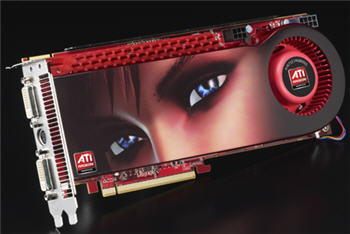From two to three GPUs with CrossfireX Quad

There was a reason that I was excited about AMD/ATi releasing the Catalyst 8.3 drivers yesterday - and that's because I had (waiting in the wings) a dual-GPU Sapphire Radeon 3870 X2 dual GPU graphics card which I wanted to fit into my main system along with a Radeon 3870 using CrossfireX Quad technology.
The system I'm fitting this card into currently holds two Radeon 3870's installed so in effect I was going from two GPUs to three with this upgrade.

Disclosure: None of this kit is "review" kit. This is stuff that I bought and paid for myself.
Here's the spec of the 3870 X2:
- 55nm process technology GPU
- Over 1 TeraFLOPS of GPU power
- 860MHz core and 1800MHz DDR clock speeds
- 1GB on-board memory
- 640 (320 x2) stream processing units
- 2 x 256-bit memory interface
- High-speed 128-bit HDR (High Dynamic Range) rendering
- Up to 24x Custom Filter Anti-Aliasing
- Unified Video Decoder (UVD) for Blu-ray and HD DVD at full HD 1080p
Before you whip out your credit card and buy a 3870 X2, a word of warning. This thing is massive. At 10.5 inches it's over 1.5 inches longer than a regular 3870 so make sure that you have room in your computer case for it (mine install was tight squeeze - my case is getting like those vacation suitcases where you need to sit on the lid to get it to closed ... I gotta do something about that). This card, like the single-GPU 3870 also eats up two slots. The card is also weighty (2.25 pounds), due to the massive heatsink assembly and a metal back brace covering most of the PCB which is there to give it structural rigidity.
Page 2 -->
Power requirements are also staggering. A single 3870 X2 also requires two 2x3-pin PCIe power connectors from your PSU (four if you intend to take two of these puppies and CrossfireX Quad them). Consider a 550W PSU a minimum. The nice design tweak on the 3870 X2 is that the connectors are along the top of the card and not at the end like on the 3870. This makes fitting the power connectors much easier.Note: CrossfireX Quad is only compatible with Windows Vista.
So, I popped the card in and rebooted (OK, it didn't pop in, it was more of a squeeze). I then had to reinstall the Catalyst 8.3 drivers and after another reboot the install process was done. Cards fitted and working and CrossfireX activated (easy - no user input needed - you need not know CrossfireX was switched on). I was ready to roll!
What about performance?
I'm glad you asked about that. So far I've not had time to carry out any detailed benchmarking but I have looked at three games and three scenarios.
The games:
- Crysis (played at 1680x1050, DX10, high settings)
- Call of Duty 4 (played at 1680x1050, extra settings)
The scenarios:
- 1 GPU (1 x 3870 cards)
- 2 GPUs (1 x 3870 X2 cards)
- 3 GPUs (1 x 3870 X2 and 1 x 3870)
Here are the results:
| Frames per second | |||
| 1 GPU | 2 GPU | 3 GPU | |
| Crysis | 12 | 20 | 22 |
| Call of Duty 4 | 51 | 86 | 110 |
| Scaling | |||
| 1 GPU | 2 GPU | 3 GPU | |
| Crysis | - | 66.6% | 83.3% |
| Call of Duty 4 | - | 68.6% | 115.7% |
I'm guessing that as drivers improve, scaling results and overall performance will increase.
As to when I plan on moving to 4 GPUs, well, I think I'll wait for a while ... maybe until I move my system to a bigger case!
Thoughts?
<< Home >>